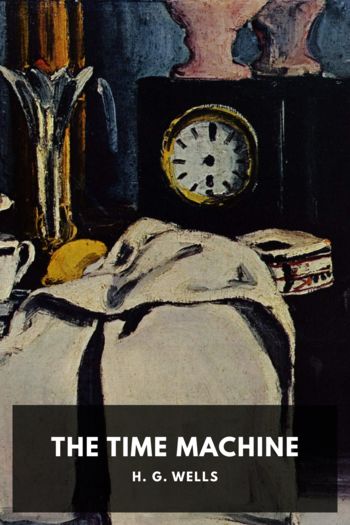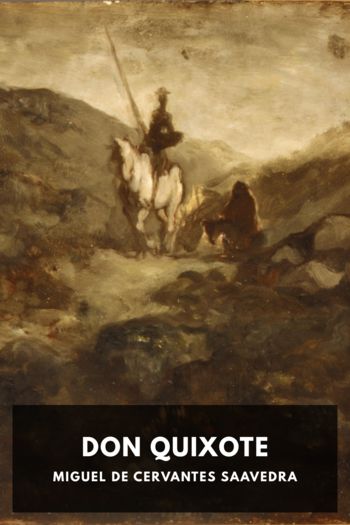The Time Machine by H. G. Wells (spanish books to read txt) 📕

- Author: H. G. Wells
Book online «The Time Machine by H. G. Wells (spanish books to read txt) 📕». Author H. G. Wells
“I found the Palace of Green Porcelain, when we approached it about noon, deserted and falling into ruin. Only ragged vestiges of glass remained in its windows, and great sheets of the green facing had fallen away from the corroded metallic framework. It lay very high upon a turfy down, and looking northeastward before I entered it, I was surprised to see a large estuary, or even creek, where I judged Wandsworth and Battersea must once have been. I thought then—though I never followed up the thought—of what might have happened, or might be happening, to the living things in the sea.
“The material of the Palace proved on examination to be indeed porcelain, and along the face of it I saw an inscription in some unknown character. I thought, rather foolishly, that Weena might help me to interpret this, but I only learned that the bare idea of writing had never entered her head. She always seemed to me, I fancy, more human than she was, perhaps because her affection was so human.
“Within the big valves of the door—which were open and broken—we found, instead of the customary hall, a long gallery lit by many side windows. At the first glance I was reminded of a museum. The tiled floor was thick with dust, and a remarkable array of miscellaneous objects was shrouded in the same grey covering. Then I perceived, standing strange and gaunt in the centre of the hall, what was clearly the lower part of a huge skeleton. I recognized by the oblique feet that it was some extinct creature after the fashion of the Megatherium. The skull and the upper bones lay beside it in the thick dust, and in one place, where rainwater had dropped through a leak in the roof, the thing itself had been worn away. Further in the gallery was the huge skeleton barrel of a Brontosaurus. My museum hypothesis was confirmed. Going towards the side I found what appeared to be sloping shelves, and clearing away the thick dust, I found the old familiar glass cases of our own time. But they must have been airtight to judge from the fair preservation of some of their contents.
“Clearly we stood among the ruins of some latter-day South Kensington! Here, apparently, was the Palaeontological Section, and a very splendid array of fossils it must have been, though the inevitable process of decay that had been staved off for a time, and had, through the extinction of bacteria and fungi, lost ninety-nine hundredths of its force, was nevertheless, with extreme sureness if with extreme slowness at work again upon all its treasures. Here and there I found traces of the little people in the shape of rare fossils broken to pieces or threaded in strings upon reeds. And the cases had in some instances been bodily removed—by the Morlocks as I judged. The place was very silent. The thick dust deadened our footsteps. Weena, who had been rolling a sea urchin down the sloping glass of a case, presently came, as I stared about me, and very quietly took my hand and stood beside me.
“And at first I was so much surprised by this ancient monument of an intellectual age, that I gave no thought to the possibilities it presented. Even my preoccupation about the Time Machine receded a little from my mind.
“To judge from the size of the place, this Palace of Green Porcelain had a great deal more in it than a Gallery of Palaeontology; possibly historical galleries; it might be, even a library! To me, at least in my present circumstances, these would be vastly more interesting than this spectacle of oldtime geology in decay. Exploring, I found another short gallery running transversely to the first. This appeared to be devoted to minerals, and the sight of a block of sulphur set my mind running on gunpowder. But I could find no saltpeter; indeed, no nitrates of any kind. Doubtless they had deliquesced ages ago. Yet the sulphur hung in my mind, and set up a train of thinking. As for the rest of the contents of that gallery, though on the whole they were the best preserved of all I saw, I had little interest. I am no specialist in mineralogy, and I went on down a very ruinous aisle running parallel to the first hall I had entered. Apparently this section had been devoted to natural history, but everything had long since passed out of recognition. A few shrivelled and blackened vestiges of what had once been stuffed animals, desiccated mummies in jars that had once held spirit, a brown dust of departed plants: that was all! I was sorry for that, because I should have been glad to trace the patent readjustments by which the conquest of animated nature had been attained. Then we came to a gallery of simply colossal proportions, but singularly ill-lit, the floor of it running downward at a slight angle from the end at which I entered. At intervals white globes hung from the ceiling—many of them cracked and smashed—which suggested that originally the place had been artificially lit. Here I was more in my element, for rising on either side of me were the huge bulks of big machines, all greatly corroded and many broken down, but some still fairly complete. You know I have a certain weakness for mechanism, and I was inclined to





Comments (0)